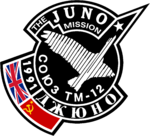Soyuz TM-12
| Mission emblem | |||
|---|---|---|---|

|
|||
| Mission dates | |||
| Mission: | Soyuz TM-12 | ||
| COSPAR-ID : | 1991-034A | ||
| Spacecraft: |
Soyuz 7K-ST ( GRAY index 11F732) serial number 62 |
||
| Dimensions: | 7160 kg | ||
| Launcher: | Soyuz U2 (GRAY index 11A511U2) | ||
| Call sign: | Озо́н (" ozone ") | ||
| Crew: | 3 | ||
| Begin: | May 18, 1991, 12:50:28 UTC | ||
| Starting place: | Baikonur 1/5 | ||
| Space station: | Me | ||
| Coupling: | May 20, 1991, 14:30:43 UTC | ||
| Decoupling: | October 9, 1991, 20:55:08 UTC | ||
| Landing: | October 10, 1991, 04:12:18 UTC | ||
| Landing place: | 67 km SE of Arkalik | ||
| Flight duration: | 144d 15h 21min 50s | ||
| Earth orbits: | 2260 | ||
| Rotation time : | 92.4 min | ||
| Apogee : | 397 km | ||
| Perigee : | 389 km | ||
| ◄ Before / After ► | |||
|
|||
Soyuz TM-12 is the mission name for the flight of a Soviet Soyuz spacecraft to the Soviet Mir space station . It was the twelfth visit by a Soyuz spaceship to the Mir space station and the 88th flight in the Soviet Soyuz program.
crew
Starting crew
- Anatolyj Arzebarskyj (1st space flight), commander
- Sergei Konstantinowitsch Krikaljow (2nd space flight), flight engineer
-
Helen Patricia Sharman (1st Spaceflight), Science Cosmonaut ( UK )

Substitute team
- Alexander Alexandrovich Volkov , commandant
- Alexander Jurjewitsch Kaleri , flight engineer
-
Timoti Kristian Charles Mace , Science Cosmonaut ( United Kingdom )

Return team
- Anatolyj Arzebarskyj (1st space flight), commander
- Toktar Ongarbajewitsch Aubakirow (1st space flight), flight engineer
-
Franz Viehböck (1st space flight), science cosmonaut ( Austria )

Mission overview
Arzebarski and Krikaljow replaced the old crew, the British Sharman returned with them after a week-long flight in the Mir space station. The mission, paid for by British companies, mainly involved biological and chemical experiments. Helen Sharman also gave a lesson that was broadcast live to British classrooms.
For the ninth permanent crew, experiments in astronomy, biology, chemistry, earth exploration, space technology, materials science and medicine were on the program. In addition, the cosmonauts carried out maintenance work and changed several devices for new systems. Their outboard work to repair an antenna for the course approach system on the Kwant module and to assemble a 14-meter-long foldable lattice mast made of a novel titanium-nickel alloy for an additional control unit on the Kwant module was also important. With a total of six exits, the two cosmonauts worked 32 hours and 23 minutes in space. During their mission, they received supplies from the Progress M-8 and M-9 transport spacecraft . Sergej Krikaljow had to stay in space six months longer than planned, as the next two planned missions were merged due to lack of funds and therefore only one member of the regular crew could be replaced.
Data of the six spacewalks of Arzebarski and Krikalev during the mission Soyuz TM-11:
24.06. 4:53 h Replacement of an antenna
28.06. 3:24 h Repair of the antenna for the proximity system course, installation of a laser reflector and replacement of devices
07/15. 5:45 a.m. Assembly of a foldable platform
19.07. 5:28 h Assembly of a mast for a new drive unit for better position control of the orbital
complex (SOFORA) 23.07. 5:34 h load test of the SOFORA mast
27.07. 6:49 h Another test of the SOFORA mast
See also
Web links
- Soyuz TM-12 at spacefacts.de
- Soyuz TM-12 at space.kursknet.ru (English / Russian , archived 2016)
- Soyuz TM-12 in the Encyclopedia Astronautica (English)
- Soyuz TM-12 in the NSSDCA Master Catalog (English)
- Project page AUSTROMIR-91 including landing of Soyuz TM-12

